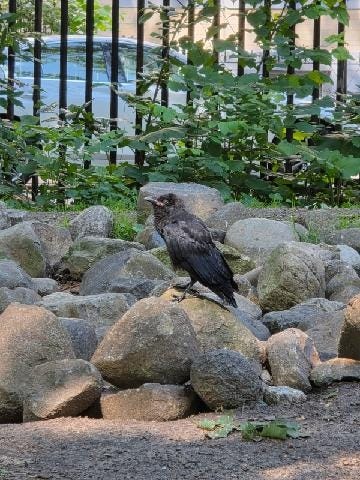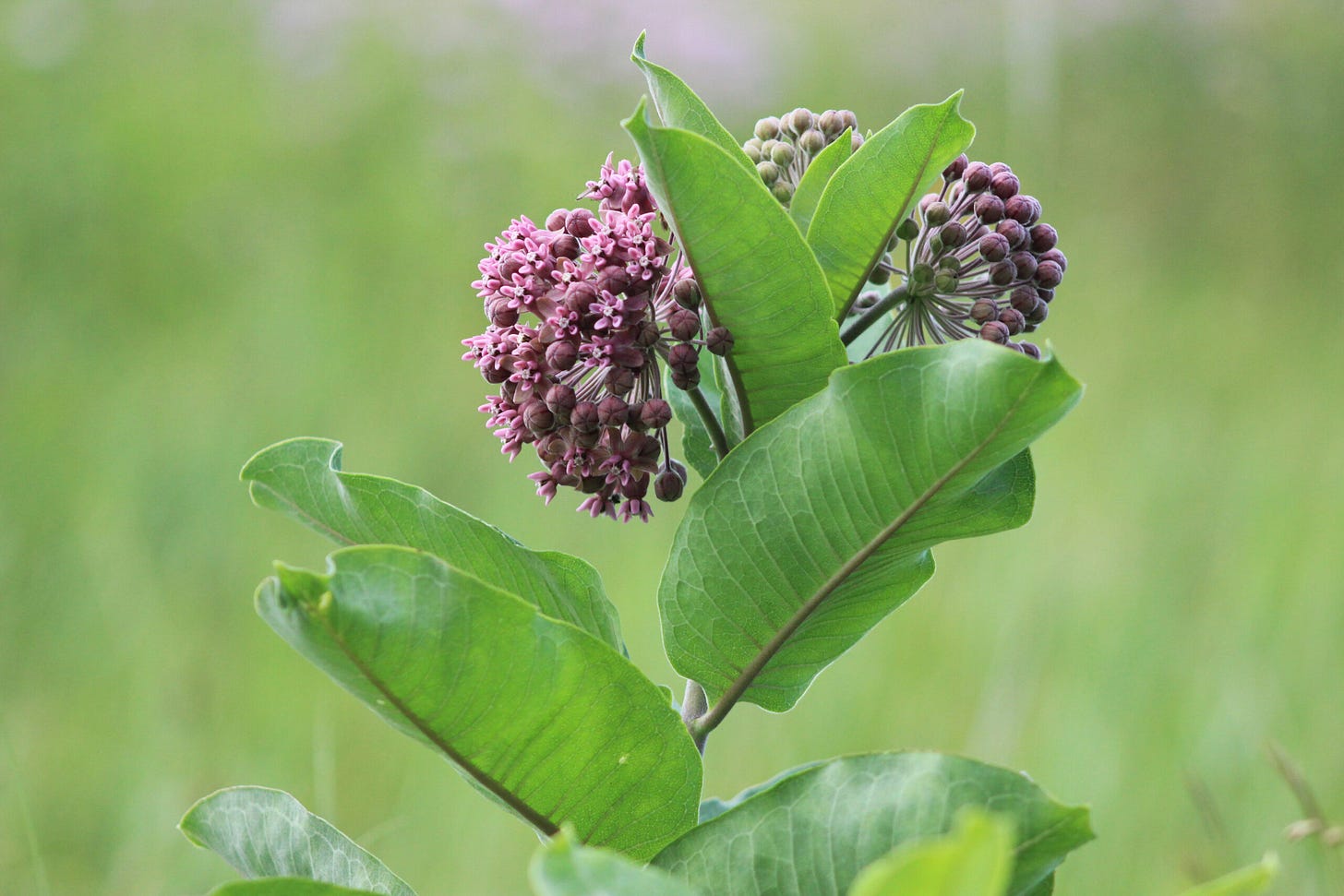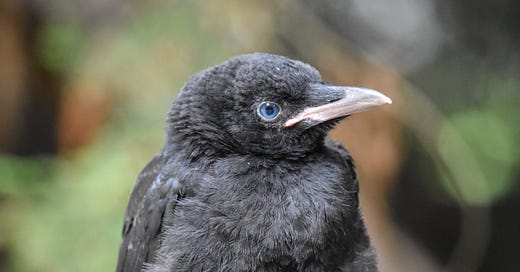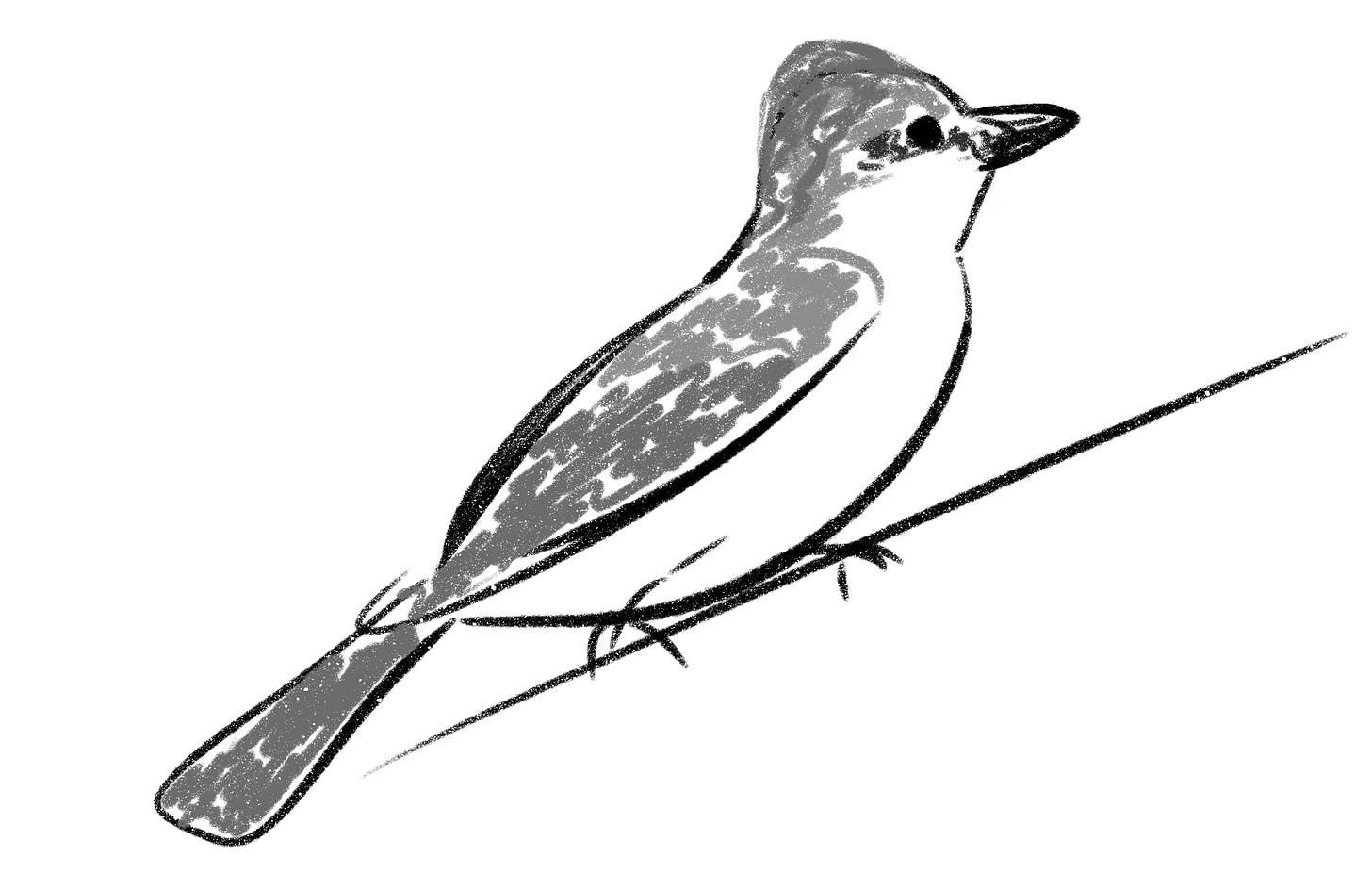Top story: A Lot of Bad.
But then: Fish Crows—squawking awe awe from McGolrick Park’s trees like enlightened cheerleaders.
(That’s awe, not the American Crow caw. And ask if they’re American—they’ll say uh uh, mad nasally.)
What are the fishy C’s cheering for?
A ground-dwelling silhouette, puttering around the bushes. Look closer:

—pink mouth, stubby tail, slightly wobbly.
A fledgling.
Welcome to the world, little Fish Crow 🖤
And welcome back (you—dear reader). We’re very glad to see you.
A FEW QUICK ANNOUNCEMENTS!
1.) So yeah, at time of writing, there’s a fledgling Fish Crow in McGolrick Park!
Noticing bird fledglings isn’t as hard as it sounds. In summertime—peak bird breeding season—look for signs like smaller size, awkward movements, squawking, wing-flapping, odd bill shapes, and dusty, patchy, or matte plumage. Most importantly, watch for attentive parents swooping in to feed them.

Some fledglings may look helpless and vulnerable, but this stage is normal. Fish crows leave the nest before they can fly well. Two parents are nearby, watching and tending ours. Don’t crowd ‘em. Don’t let your wonderful dog(s) do anything mean.
2.) REVIEW OUR RECENT LESSONS
→ Learn (then spot) NYC’s oriole species.
→ Brush up on Brooklyn’s usual suspects.
→ Meet the six must-know summer herons.
3.) As always, if you aren’t yet a paid subscriber, consider becoming one! For the price of a coffee a month, you can help support our cloacal mission. Thank you!
MICROSEASON — JUNE 16 - JUNE 22
When the world feels uninhabitable—when time feels broken—it can help to inhabit the present. Not the scroll. Not the schedule. The actual present.
This is where microseasons come in:
Look wider. Listen harder. Step through the gate.
—From The 54 Microseasons of North Brooklyn. Did you read that long-y yet?
This microseason, in McGolrick Park, our urban forest proxy for NYC, and perhaps even larger swathes of the eastern U.S., one notices:

Milkweeds flower · Fish Crows fledge · Orange-day and Small-leaved plaintain lilies (non-natives) bloom
And here’s a full list of McGolrick birds:
Barn Swallow · Blue Jay · Chimney Swift · Common Grackle · Downy Woodpecker · Fish Crow · Gray Catbird · Laughing Gull · Northern Cardinal · Red-bellied Woodpecker · Plus the virtually always present in urban parks: Rock Pigeon, European Starling, American Robin, House Sparrow and Mourning Dove
Nota bene: That’s a manageable list! Summer is a great time to build you learn the basics—to build your birder base-layer.
Barn swallow? Chimney swift? Learn all them airborne birds here!
Monarchs toking milkweed in New York City are “third wave migrants” who continue a journey their dead grandparents started. We wrote about the jaw-dropping triumph that is monarch butterfly migration here!
Review our NYC butterfly primer here!
Current Japanese microseasons:
Plums turn yellow (June 16th - 20th) Self-heal withers (June 21st - 26th)
Last year’s North Brooklyn microseasons:
Fireflies emerge • Orange Day-Lilies peak (June 10th - 16th) Curling Gooseneck Loosestrifes • First Heatwave • Serviceberry exhaustion (June 17th - 23rd) Butterfly Milkweeds bloom • Barn Swallows feast • Shrubby St. John’s-worts flower • Lightning Bugs peak • Staghorn Sumacs berry (June 24th - 30th)
KINGBIRDS
Continuing our nascent tradition of shouting out NYC’s sultriest summerers, we arrive at:
Eastern Kingbird—The Eastern Kingbird is an approx. robin-sized, black-and-white flycatcher with a bold white tail tip and a neat, hooded tuxedo look.
They perch confidently on wires and treetops, then sweep into the air to snatch flying insects, often before returning to the same place. (That’s what birders call flycatching.)
They come to us from—ZOMG—wintering grounds in middle South America!
Need help reading those psychedelic bird range maps like the one linked-to above? Review our primer here!
Though you won’t find the below beauties anywhere near Brooklyn, we’re tacking on two more kingbirds you simply must know.
(Shoutout to our California and Florida readers!)
Western Kingbird—These dudes summer across the western U.S., from the Great Plains to the Pacific, especially in open country and farmland. Pale-gray head, lemon-yellow belly, brown wings. Listen for sharp kip calls.
Gray Kingbird—Pale-gray topped flycatcher with a nice mask. Common in coastal Florida and the southeastern U.S. in summer, especially along utility lines near mangroves, beaches, and tropical suburbs. Staccato kip-kip-kip calls.
In Brooklyn? Want to find an Eastern Kingbird, like, today?
Eastern Kingbirds are regulars in Kings County’s larger parks—especially around water. For probable views, try:
Prospect Park Lake – starting around this wooded area, circle the lake clockwise; check tall trees
Green-Wood Cemetery – keep your senses on and your head up around Sylvan Water







